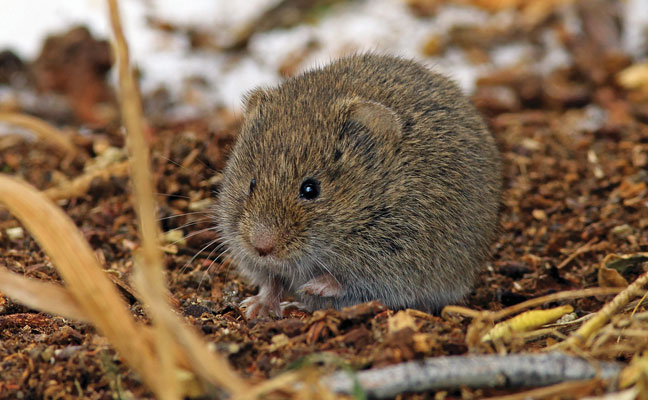
This mostly outdoor pest can wreak havoc in customers’ yards and lawns. Photo: photographybyJHWilliams/iStock / Getty Images Plus/Getty Images
Meadow voles, also known as meadow mice, are among the most prolific, numerous and widely distributed mammals in North America. These stocky rodents are about 7 inches long as adults. The tail is usually short, about 1.5 inches. Their ears are furred and do not project much above the hair on the head.
Mature meadow voles are chestnut brown, mixed with black on the back. Their under parts are dark gray, and their feet are brown. The thinly haired tail is dark on the upper surface, shading to a lighter gray beneath. Young meadow voles are uniformly gray.
It is easy to confuse meadow voles with moles and shrews in the field. Moles can be distinguished from voles because they are considerably larger and have greatly enlarged front feet with prominent digging claws. Shews are smaller, more slender mammals. They have extremely soft fur; long, pointed snouts; and needle-like front teeth. Plus, a shrew’s eyes and ears are not easily seen. By contrast, meadow voles have rounded, somewhat blunt snouts and visible ear flaps, and their front teeth are shaped like chisels.
Meadow vole populations fluctuate from year to year. Several hundred voles per acre may be present in years when they are abundant, and they may be extremely destructive to vegetation. Their usual foods are grasses and herbs, but during late fall, winter and early spring, they may “girdle,” or gnaw, the bark of young trees and ornamental plantings — especially when snow cover is present. This can cause damage and even death to the plant.
Voles can produce five to 10 litters per year, with an average of five young per litter. Gestation is about 21 days, and females may mate again the same day their young are born. Young voles grow quickly, are weaned within three weeks, and are sexually mature in a month or two.
In regions that receive snow, homeowners may be dismayed when the snow has melted to see the ragged and chewed-up appearance of the grass where voles have been living underneath the snow all winter. In most cases, however, the damage to the lawn is not permanent. This vole activity is sometimes blamed on moles, but moles dig their tunnels beneath the soil surface and do not construct surface runways through the grass.
In cases of just a few voles in and around ornamental plantings, ordinary mouse-size snap traps are effective. If possible, locate the vole runways in grassy borders of the gardens, and set the traps at right angles to these runways. The trigger should be in the runway. A pinch of oatmeal sprinkled on the trigger can help attract them. Reset and bait traps daily until no more voles are caught. Keep grassy and weedy areas well-mowed to reduce protective cover for voles (and other pests). Bait stations are effective in larger infestations.
Voles as “house guests”
Voles occasionally enter buildings, but they do not tend to become established or reproduce indoors. Treat indoor populations as you would for a house mouse account, with an integrated approach of snap traps, glue boards and other methods as warranted.
REFERENCE
Truman’s Scientific Guide to Pest Management Operations, Seventh Edition, available for purchase at MyPMP.net/shop.
Leave A Comment